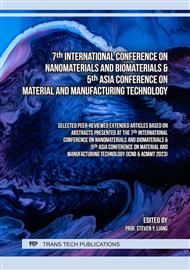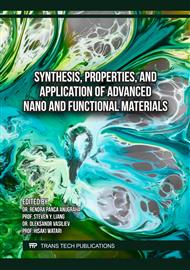[1]
Agency for Environmental Protection (EPA) Federal Law on Control of Water Pollution "Clean Water Act". United States of America. 1977.
Google Scholar
[2]
Hernández-Montoya V, Pérez-Cruz MA, Mendoza-Castillo DI, Moreno-Virgen MR, Bonilla- Petriciolet A. Competitive adsorption of dyes and heavy metals on zeolitic structures. Journal of Environmental Management. 2013;116:213-221. DOI: 10.1016/j. jenvman.2012.12.010.
DOI: 10.1016/j.jenvman.2012.12.010
Google Scholar
[3]
Tang WW, Zeng GM, Gong JL, Liang J, Xu P, Zhang C, Huang BB. Impact of humic/ fulvic acid on the removal of heavy metals from aqueous solutions using nanomaterials: A review. Science of the Total Environment. 2014;468:1014-1027. DOI: 10.1016/j. scitotenv.2013.09.044.
DOI: 10.1016/j.scitotenv.2013.09.044
Google Scholar
[4]
Lesmana SO, Febriana N, Soetaredjo FE, Sunarso J, Ismadji S. Studies on potential applications of biomass for the separation of heavy metals from water and wastewater. Biochemical Engineering Journal. 2009;44:19-41..
DOI: 10.1016/j.bej.2008.12.009
Google Scholar
[5]
Zeng G, Liu Y, Tang L, Yang G, Pang Y, Zhang Y, Zhou Y, Li Z, Li M, Lai M, He X, He Y. Enhancement of Cd(II) adsorption by polyacrylic acid modified magnetic mesoporous carbon. Chemical Engineering Journal. 2015;259:153-160.
DOI: 10.1016/j.cej.2014.07.115
Google Scholar
[6]
Masoumi A, Ghaemy M, Bakht AN. Removal of metal ions from water using poly(MMAco- MA)/modified-Fe3O4 magnetic nanocomposite: Isotherm and kinetic study. Industrial and Engineering Chemistry Research. 2014;53:8188-8197.
DOI: 10.1021/ie5000906
Google Scholar
[7]
Deang, A.B.G., Alcantara, R.S.A., Bayot, J.B., Ledesma, N.K.D., Vasquez, V.L.J.L., & Millare, J.C. (2022). Nanozeolite-Impregnated Polysulfone/Polyethylene Glycol Nanocomposite Membrane for Ion Adsorption Application. In Key Engineering Materials (Vol. 907, p.173–178). Trans Tech Publications, Ltd.
DOI: 10.4028/www.scientific.net/kem.907.173
Google Scholar
[8]
Valeros, A.A., Panganiban, A., & Millare, J.C. (2022). Fabrication and Characterization of Nanozeolite-Modified High Impact Polystyrene (HIPS) Membranes for Nanofiltration. In Key Engineering Materials (Vol. 931, p.93–98). Trans Tech Publications, Ltd. https://doi.org/.
DOI: 10.4028/p-t8746y
Google Scholar
[9]
Saeed Shanbehzadeh, Marzieh Vahid Dastjerdi, Akbar Hassanzadeh, and Toba Kiyanizadeh. Heavy Metals in Water and Sediment: A Case Study of Tembi River. https://doi.org/
DOI: 10.1155/2014/858720
Google Scholar
[10]
Ioannis Anastopoulos, Alok Mittal, Muhammad Usmanc, Jyoti Mittal,Guanghui Yue,5, Avelino Núñez-Delgado, Michael Kornaros. A review on halloysite-based adsorbents to remove pollutants in water and wastewater.
DOI: 10.1016/j.molliq.2018.08.104
Google Scholar
[11]
N.B. Singh, Garima Nagpal, Sonal Agrawal, Rachna. Water purification by using Adsorbents: A Review
DOI: 10.1016/j.eti.2018.05.006
Google Scholar
[12]
Alijani H, Beyki MH, Shariatinia Z, Bayat M, Shemirani F. A new approach for one-step synthesis of magnetic carbon nanotubes/diatomite earth composite by chemical vapor deposition method: Application for removal of lead ions. Chemical Engineering Journal. 2014;253:456-463.
DOI: 10.1016/j.cej.2014.05.021
Google Scholar
[13]
Chen G, Qiao C, Wang Y, Yao J. Synthesis of magnetic gelatin and its adsorption property for Cr(VI). Industrial and Engineering Chemistry Research. 2014;53:15576-15581.
DOI: 10.1021/ie502709u
Google Scholar
[14]
S. Ivkovic, U. Deutsch, A. Silberbach, E. Walraph, M. Mannel, Dietary supplementation with the tribomechanically activated zeolite clinoptilolite in immunodeficiency: effects on the immune system, Adv. Ther. 21 (2004) 135–147.
DOI: 10.1007/bf02850340
Google Scholar
[15]
T. Ge, Z. Hua, X. He, J. Lv, H. Chen, L. Zhang, H. Yao, Z. Liu, C. Lin, J. Shi, On the mesoporogen-free synthesis of single-crystalline hierarchically structured ZSM-5 zeolites in a quasi-solid-state system, Chemistry 22 (2016) 7895–7905.
DOI: 10.1002/chem.201504813
Google Scholar
[16]
Dutta A.K., Rösgen J., Rajarathnam K. (2015) Using Isothermal Titration Calorimetry to Determine Thermodynamic Parameters of Protein–Glycosaminoglycan Interactions. In: Balagurunathan K., Nakato H., Desai U. (eds) Glycosaminoglycans. Methods in Molecular Biology, vol 1229. Humana Press, New York, NY.
DOI: 10.1007/978-1-4939-1714-3_25
Google Scholar
[17]
https://www.malvernpanalytical.com/en/products/technology/microcalorimetry/isothermal- titration-calorimetry.
Google Scholar
[18]
Querijero, S.C.J., Melgar, A.P.L., Suba, M.C.A. M., Lagman, M. M. G., Bucud, K. R., & Millare, J.C. (2022). Fabrication and Characterization of Cellulose Acetate/Organo-Montmorillonite Composite Membrane for Ion Adsorption. In Key Engineering Materials (Vol. 907, p.179–185). Trans Tech Publications, Ltd.
DOI: 10.4028/www.scientific.net/kem.907.179
Google Scholar
[19]
Tagalog, C.J.L., Caparanga, A.R., & Millare, J.C. (2019). Dispersion and diffusivity of halloysite and bentonite nanoclays in aqueous Pb (II): Effect of particle concentration, temperature, and pH. IOP Conference Series: Earth and Environmental Science, 344(1)
DOI: 10.1088/1755-1315/344/1/012040
Google Scholar
[20]
https://www.malvernpanalytical.com/en/products/measurement-type/binding-affinity.
Google Scholar



